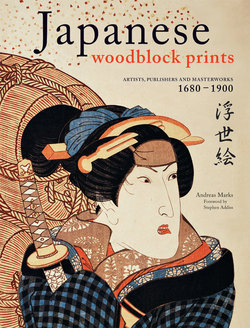Читать книгу Japanese Woodblock Prints - Andreas Marks - Страница 32
На сайте Литреса книга снята с продажи.
ОглавлениеShunman
1757–1820
Family name: Kubota, Kubo. Given names: Toshimitsu, Yasubei. Art names: Kōzandō, Sashōdō. Poet names: Issetsu Senjō, Nandaka Shiran, Shōsadō.
Kubo Shunman, born in 1757, was orphaned at an early age. He studied under Kitao Shigemasa as well as under the poet Katori Nahiko (1723–1782). Active from the 1770s, he created only a few commercial prints of elegant beautiful women and pictures of customs and manners (fūzokuga) in the style of Torii Kiyonaga. These women were often set in landscapes and published by Wakasaya Yoichi or Fushimiya Zenroku, who also published his most famous composition, an untitled hexaptych of women juxtaposed to the “Six Jewel Rivers” (mu tamagawa) of which one sheet is illustrated in the figure on the next page. Shunman was active as a painter and later specialized in surimono. He is said to be the first who employed the subject of still life. His earliest work, made in 1774, was a copy of a votive plaque by Nahiko.
Between 1779 and 1820, Shunman illustrated also a number of books, some of them erotic. Early in his career, from c.1779–84, he wrote and illustrated novels under the name Nandaka Shiran. He was a prolific poet and member of the poem clubs Bakuro-ren and Rokujuen. Originally, his poet name was Hitofushi Chitsue. After the death of the founder of the Bakuro-ren, Tsumuri no Hikaru, Shunman became the new leader and judge of the club. He abandoned designing commercial single-sheet prints in around 1790 and fully concentrated on kyōka surimono (crazy verse deluxe prints) to become their foremost designer. He wrote the poems for books illustrated by Katsushika Hokusai, Kitagawa Utamaro, and Hosoda Eishi. With over seventy extant paintings, Shunman was the most prolific painter of the Kitao school. He died, aged 64, on the 20th day of the ninth month 1820.
1812 The monkey Songokū from Journey to the West. 13.7 x 21 cm (5.4 x 8.25 in.). Library of Congress.
Late 1790s Snow on Mt. Koro. Fan print. Library of Congress.
1780s Far right panel from the first edition of an untitled hexaptych of women juxtaposed to the “‘Six Jewel Rivers’” (mu tamagawa). ōban. Publisher: Fushimiya Zenroku. Asian Art Museum, National Museums in Berlin. The complete hexaptych is illustrated in Genshoku ukiyo-e dai hyakka jiten, vol. 7, no. 193, p. 72.
